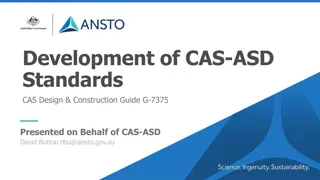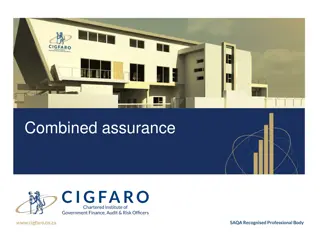Understanding CAS Standards and Quality Assurance in Higher Education
Explore the Council for the Advancement of Standards in Higher Education (CAS) and its impact on quality assurance in higher education. Learn about CAS functional areas, professionalism criteria, and how CAS standards are used for program assessment. Gain insights into the vision and mission of CAS in setting quality standards for student learning, programs, and services.
Download Presentation

Please find below an Image/Link to download the presentation.
The content on the website is provided AS IS for your information and personal use only. It may not be sold, licensed, or shared on other websites without obtaining consent from the author. Download presentation by click this link. If you encounter any issues during the download, it is possible that the publisher has removed the file from their server.
E N D
Presentation Transcript
Learning Goals Identify approaches to quality assurance and the use of professional standards in higher education Describe CAS and the CAS standards Articulate how the CAS standards can be used for program self-assessment
Council for the Advancement of Standards in Higher Education Founded in 1979 (40th Anniversary) Consortium of 42 member organizations Council comprised of representatives from member associations Consensus-oriented, collaborative approach 48 sets of functional area standards and self- assessment guides (SAGs) 3 Cross-Functional Frameworks
CAS Functional Areas Internship Programs Learning Assistance Programs LGBTQ+ Programs and Services Master s Level Student Affairs Professional Preparation Programs Multicultural Student Programs and Services Orientation Programs Parent and Family Programs Post-Traditional and Commuter Student Programs and Services Registrar Programs and Services Sexual Violence-Related Programs and Services Student Conduct Programs Student Leadership Programs Student Media Programs Sustainability Programs Testing Programs and Services Transfer Student Programs and Services TRIO and College Access Programs Undergraduate Admissions Programs and Services Undergraduate Research Programs Veterans and Military-Connected Programs and Services Women s and Gender Programs and Services
Criteria for Professionalism Established philosophy is in place Professional preparation exists with a body of knowledge Research is underway developing theories and analyzing practice Professionals are employed full-time Professional organizations are in place Professional standards are established
CAS Vision and Mission CAS Vision Setting the standard for quality in higher education. CAS Mission CAS, a consortium of professional associations in higher education, promotes the use of its professional standards for the development, assessment, and improvement of quality student learning, programs, and services (CAS, 2015).
Principles Underlying All CAS Standards Students and Their Environments Parts 1. Mission; 2. Programs and Services; 3. Student Learning, Development, and Success, and 4. Assessment Advocating for Diverse, Equitable, and Inclusive Communities Part 5. Access, Equity, Diversity, and Inclusion
Organization, Leadership, and Human Resources Parts 6. Leadership, Management, and Supervision; 7. Human Resources; and 8. Collaboration and Communication Ethical Considerations Part 9. Ethics, Law, and Policy Learning-Conducive Structures, Resources, and Systems Parts 10. Financial Resources; 11. Technology; and 12. Facilities and Infrastructure
Applications for CAS Standards Design new programs and services Focus time, energy, and resources Devise staff development Guide strategic planning Develop learning and development outcomes Measure program and service effectiveness
The General Standards (2018) 1. 2. 3. 7. 8. Mission Program and Services Student Learning, Development, and Success Assessment Access, Equity, Diversity, and Inclusion Leadership, Management, and Supervision Human Resources Collaboration and Communication Ethics, Law, and Policy 10. Financial Resources 11. Technology 12. Facilities and Infrastructure 9. 4. 5. 6.
Standards are comprised of Two Types of Statements General Standards Common across all functional areas Appear verbatim in every set of functional area standards Functional Area Standards Address issues specific to the functional area. The mission of Career Services (CS) is to assist students and other designated clients in developing, evaluating, and implementing career, education, and employment readiness goals. The functional area must develop and define its mission.
Understanding Standards & Guidelines Standards Guidelines Indispensable requirements Clarify & amplify Standards Achievable by any & all programs of quality Guide enhanced practice beyond essential function Appear in light-faced type Appear in bold type Use verbs should & may Use must & shall
CAS Learning and Domains and Dimensions
Student Learning, Development, and Success Section Six Student Learning & Development Outcome Domains are a part of the CAS General Standards Stated expectation in the CAS General Standards that all functional area programs must place emphasis on identifying relevant learning outcomes and assessing their achievement by students
CAS Learning and Development Outcomes Part of the CAS General Standards Knowledge acquisition, construction, integration, and application Cognitive Complexity Intrapersonal Development Interpersonal Competence Humanitarianism and Civic Engagement Practical Competence
Student Learning, Development, and Success Section The functional area MUST Provide evidence of the extent to which student learning and development outcomes are achieved Use evidence to create strategies for improving student learning, development, and success
Creating Intentional Outcomes CAS learning and development outcomes address the whole student Functional areas directly influence or contribute to each outcome Outcomes may be more significant to a program or service than others; all should be on radar Identify desired outcomes before designing programs Input Environment Outcome
Fundamental Assessment Questions Program Evaluation Is the program or service functioning effectively to achieve its mission? What evidence is available to support the determination? Learning and development outcomes are part of this evidence How is evidence used to make program decisions? Student Learning and Development Outcomes What is the effect of our work on students? How are they different as a result of interacting with our programs and services? How do we know? How do we demonstrate their learning? What and how do we measure?
Applying the Outcomes 1. Writing learning outcome statements 2. Aligning learning experiences across an institution 3. Guiding assessment plans 4. Engaging students in learning opportunities 5. Preparing for a self-assessment
CAS Self-Study Overview and Application
CAS Fundamentals about Self- Assessment Internally driven Systematic and regular Effective in terms of time, cost, etc. Provides reasonably accurate, useful information Supports staff development Provides recognition and rewards at a local level
CAS Fundamentals about Self- Assessment Charts quality program development and professionalism using widely agreed-upon quality indicators Develops a shared vision among constituents Relies on honesty with meticulous evaluation Assembles results into an action plan for improvement
Self-Assessment Guides (SAGs) Provides an effective workbook/format for evaluation, self-assessment, and institutional reviews Translates standards into multiple criterion statements which can be measured Clusters of criterion measures focus on subsections of the standards, allowing raters to express detailed and targeted judgments Informs on program strengths and weaknesses Leads to an action plan to enhance programs and services that benefit student learning and development
2019 CAS SAG Space for rating of each subpart (ex: 4.1) - Simplified scale for evaluation - Space to write your narrative explanation of above ratings
CAS Program Review Steps The Improvements The Process The Report The Team The Action Plan The Evidence The Ratings
Decisions to be Made Before Beginning What is your purpose for using the CAS standards? Assessment and/or accreditation Other purposes How much do you want to know? Extensive study or snap shot? Do you have other things on the agenda? Enhance collaboration Enhance consistency between campus sites Need evidence to increase funding, facilities, or staffing
Plan the Process Take stock of the current assessment landscape Map out your steps Identify outcomes for self-study Develop a preliminary timeline
Sample Timeline By Feb. 15: Team Selection By March 15: Team Training Mar. 15-May 15: Compile and Review Documentary Evidence May 15-June 30: Judging Performance
Assemble and Educate Team Identify an individual to coordinate self-assessment Coordinator should not be the unit leader; ideally, appoint someone outside the unit Identify and invite members of the institutional community to participate Internal and external composition could include: 1 staff member from elsewhere in the division 1 staff member from outside the division 1 faculty member 1 student
Assemble and Educate Team Recommended size of team 3-5 members for a single functional area, comprised of stakeholders including students 8-10 members for a diverse department or division, comprised of stakeholders including students
Assemble and Educate Team Include representatives from key stakeholder groups Think about the power dynamics Which set-up works best for the personalities and experience level of your group? Chair, Co-chairs, Chair and Vice Chair, Others?
Assemble and Educate Team Make sure the team Reviews the standards/criteria being used for the self-assessment Arrives at consensus about rating scale definitions Agrees on guidelines for discussions Discusses expectations for timeline, responsibilities, and process Discusses the expectations for the group s final product
Assemble and Educate Team Hold a training session Establish team ground rules Review standards and guidelines Discuss meaning of each standard Establish team s inter-rater reliability Discuss, consider, and set criteria Build a common language (i.e. partly meets, meets, standards)
Assemble and Educate Team Encourage team discussion, expect disagreements, and commit to consensus- based resolution Make sure the team has a big-picture understanding of the responsibilities of the area being reviewed (e.g., some stakeholders may only be aware of some of this work) Communicate expectations for the group s final product
Identify, Collect, and Review Evidence
Identify, Collect, and Review Evidence Design process for compiling evidence and data (Unit)
Identify, Collect, and Review Evidence Gather evidence and data (Unit) Use relevant data and related documentation Routinely collect and file data that can be used to document program effectiveness over time Needed evidence will vary depending on what s being evaluated
Identify, Collect, and Review Evidence Conduct rating (Review Team) Should rate all standards, but sometimes a standard won t apply (rarely) Employ evidence-based evaluation Team uses rating scale based on established criteria Individuals rate each and every criterion measure and then gather consensus
Documentary Evidence to Support Evaluative Judgments Student Recruitment and Marketing Materials Program Documents Institutional Administrative Documents Research, Assessment, and Evaluation Data Staff Activity Reports Student Activity Reports
Conduct and Interpret Ratings Using Evaluative Evidence
Conduct and Interpret Ratings Using Evaluative Evidence A two-tiered judgment approach (individual and group) to determine the extent to which the program meets the CAS Standards is suggested Individual ratings should be reviewed and translated into a collective rating before the team moves to the interpretation phase of the self-assessment
Conduct and Interpret Ratings Using Evaluative Evidence Interpretation incorporates discussion among team members to ensure that all aspects of the program were given fair consideration prior to a final collective judgment After the team review is completed, meet with administrators, staff members, and student leaders to review self-assessment results
Develop an Action Plan Respond to the Overview Questions at the end of each rating section Identify good practice and areas of improvement Make recommendations for next steps Articulate recommendations, resources, timeframe, and responsible individuals
Develop an Action Plan Programmatic Action Plan Detail actions required for the program to meet all standards Identify areas that need follow-up because they are less than satisfactory List resources necessary for program enhancements Include a timeline and deadline Identify person/people responsible for completing the work Final Reports Due
Develop an Action Plan Strategic Action Plan Complete a full review of each program/service every 3-5 years Conduct mini-reviews of units between years Gather data and information about programs/services between larger-scale reviews Incorporate self-assessment tasks in ongoing projects Use CAS self-assessment findings and data to inform future strategic planning efforts























